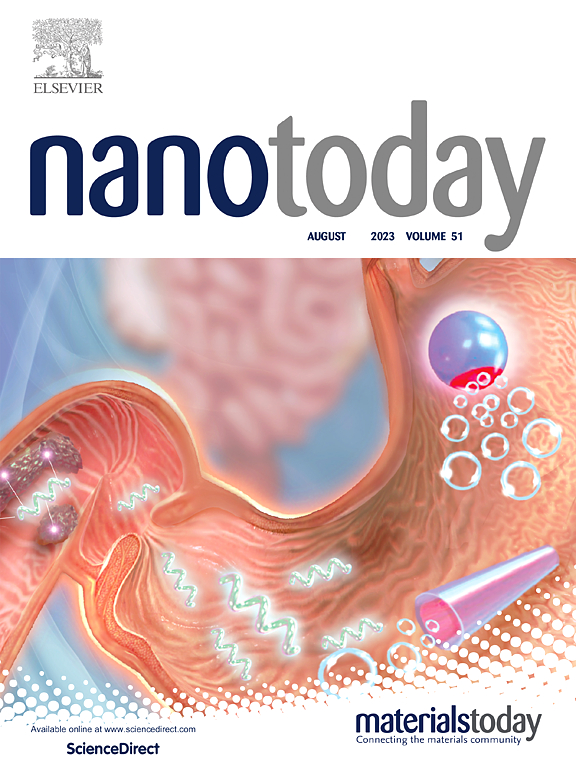Achieving apoptosis/cuproptosis co-activated synergistic anti-tumor therapy by charges transport engineering
IF 13.2
1区 材料科学
Q1 CHEMISTRY, MULTIDISCIPLINARY
引用次数: 0
Abstract
Nanocatalysts show great promise in nanomedicine due to their unique catalytic activities. However, the rapid recombination of excited electrons and holes leads to low efficacy of nanocatalytic therapy. Herein, ultrasmall S-Scheme heterojunction MoC/CuFeOx nanoparticles (MCFO NPs) with specific charge transport route are rationally designed and engineered for efficient apoptosis/cuproptosis co-activated nanocatalytic therapy. Thermal analysis revealed two steps of S-Scheme heterojunction formation: adsorption and internal structure change. In this structure, the staggered energy levels and band bending enhance the separation of photogenerated electrons and holes, improving redox capacity and catalytic activity, mediating O2 production, regulating the hypoxic tumor microenvironment, increasing reactive oxygen species, and inducing apoptosis. Additionally, due to excessive copper, the oligomerization of lipoylated dihydrolipoamide S-acetyltransferase and disruption of tricarboxylic acid cycle are caused to evoke cuproptosis. This work proposes a feasible strategy to enhance the nanocatalytic therapeutic efficacy through charge transport engineering, thereby mediating apoptosis/cuproptosis co-activated synergistic anti-tumor therapy.
利用电荷传输工程实现细胞凋亡/细胞凋亡共激活协同抗肿瘤治疗
纳米催化剂以其独特的催化活性在纳米医学领域显示出巨大的应用前景。然而,受激电子与空穴的快速复合导致纳米催化治疗的效率较低。本文合理设计了具有特定电荷传输路径的超小S-Scheme异质结MoC/CuFeOx纳米颗粒(MCFO NPs),用于高效的细胞凋亡/ cuproosis共激活纳米催化治疗。热分析揭示了s型异质结形成的两个步骤:吸附和内部结构变化。在这种结构中,交错能级和能带弯曲增强了光电子和空穴的分离,提高了氧化还原能力和催化活性,介导了O2的产生,调节了缺氧肿瘤微环境,增加了活性氧,诱导了细胞凋亡。此外,由于过量的铜,引起脂酰化二氢脂酰胺s -乙酰转移酶的低聚化和三羧酸循环的破坏,引起铜还原。本研究提出了一种可行的策略,通过电荷传输工程来提高纳米催化治疗效果,从而介导细胞凋亡/铜细胞凋亡共激活协同抗肿瘤治疗。
本文章由计算机程序翻译,如有差异,请以英文原文为准。
求助全文
约1分钟内获得全文
求助全文
来源期刊

Nano Today
工程技术-材料科学:综合
CiteScore
21.50
自引率
3.40%
发文量
305
审稿时长
40 days
期刊介绍:
Nano Today is a journal dedicated to publishing influential and innovative work in the field of nanoscience and technology. It covers a wide range of subject areas including biomaterials, materials chemistry, materials science, chemistry, bioengineering, biochemistry, genetics and molecular biology, engineering, and nanotechnology. The journal considers articles that inform readers about the latest research, breakthroughs, and topical issues in these fields. It provides comprehensive coverage through a mixture of peer-reviewed articles, research news, and information on key developments. Nano Today is abstracted and indexed in Science Citation Index, Ei Compendex, Embase, Scopus, and INSPEC.
 求助内容:
求助内容: 应助结果提醒方式:
应助结果提醒方式:


